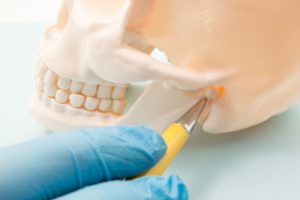
According to the National Institute of Dental and Craniofacial Research, TMJ disorder is a chronic condition that impacts between five and 12 percent of the population. However, this condition is more prevalent in younger patients. Your temporomandibular joints are what connects your jawbone to your skull, and when they’re not working properly, that can make it uncomfortable completing daily tasks such as eating or speaking. Read on to learn what symptoms to look out for and how you can get this painful condition treated.
What Causes TMJ Disorder?
Professionals believe that symptoms of TMJ disorder can arise for a variety of reasons, including injury to the jaw, the temporomandibular joints themselves, or the muscles of your head and neck. However, research has also shown that there are other causes, including:
- Regular grinding or clenching of your teeth, which places significant pressure on the joints themselves.
- Movement of the soft cushion that’s located between the ball and socket of the joint.
- Arthritis in the joint.
- Stress, which leads to clenching teeth.
If you believe you’re at an increased risk of experiencing TMD, it’s important to visit your dentist every six months to discuss whether they can provide you with relief from your symptoms. From there, they can develop a customized treatment plan for you.
What are the Symptoms of TMJ Disorder?
TMJ disorder is a chronic and painful condition that makes it difficult to complete certain basic daily functions like eating and speaking. Fortunately, your dentist can help ease your discomfort as long as you visit them when you first spot the symptoms, which include:
- Tenderness and discomfort in the face, jaw, neck, shoulders, and around the ear.
- Limited ability to widely open your mouth.
- Your jaw becomes locked open or closed.
- Clicking, popping, and grating sound while opening or closing your mouth.
- General pain when using the joints.
- Tired feeling in the face.
- Difficulty chewing.
- Swelling on the side of the face.
- Headaches.
People who have TMD can feel significant pain and discomfort that can last for months or years and is most common in people between the ages of 20 and 40. The best way to keep this chronic condition from impacting the quality of your daily life is to schedule a consultation with your dentist to learn what treatment options they offer.
How Can You Treat Your TMJ Pain?
If you’re experiencing a variety of TMD symptoms, your dentist may use TruDenta technology to develop a drug-free treatment plan that can help relieve the uncomfortable and life-altering symptoms you’re experiencing. Your dentist will complete a thorough examination of the nerves and muscles around your head, neck, and jaw to develop a detailed therapy plan individualized for your unique needs.
If you’d like to learn how you can ease your pain associated with TMJ disorder, don’t hesitate to contact your dentist today to schedule a consultation. With high-tech and thorough treatment, you’ll be able to continue living your life without the added weight of constant discomfort.
About the Author
Dr. Stephen Dean has completed advanced training and education in specialty dental topics including sleep apnea treatment and TMD therapy. He is an active member of the Academy of Clinical Sleep Disorder Disciplines as well as the American Board of Dental Sleep Medicine, which allows him to stay up-to-date with the latest advancements in his specialty interests. He uses the latest technology, including TruDenta, which is an FDA-cleared therapy system that eases his patient’s pain caused by chronic disorders such as sleep apnea and temporomandibular joint imbalances. For questions or to schedule a consultation to learn more about how Dr. Dean can help get rid of your migraines and jaw pain, visit Dean Dental Care’s website or call 770-786-3915.

